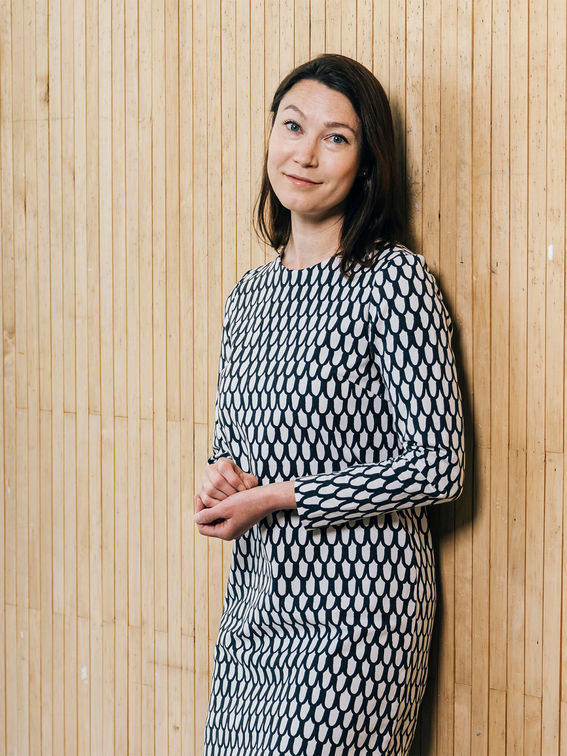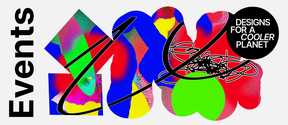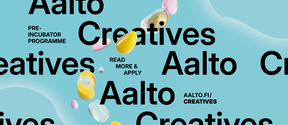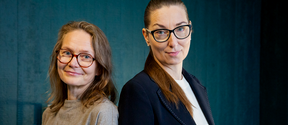PechaKucha Night at Aalto
PechaKucha Night at Aalto on Sept 6, 2023, brings together ten speakers who will all have six minutes and forty seconds to tell a story to entertain, engage and inspire – what will they do with this precious time?

When you live as a human in a human-centred world, you rarely consider that animals interact, and work for and with humans in various roles.
In her research, Associate Professor Astrid Huopalainen explores the conscious and unconscious uses of power in human-animal interactions.
As humans, we act from a position of power in relation to other animals. Even something as trivial and endearing as walking a dog reveals the unequal power structures between humans and animals – something Huopalainen also recognises in her everyday life.
‘As humans, we decide when and for how long our pets are walked. When I walk my Labrador retrievers Saga and Selma in the morning, I try to pay attention to how they would like us to walk and how they see the world differently than I do, sensing and smelling different things. That urges me to stop and reflect and perhaps try to see things differently, activating my senses and seeing these positions of power from their point of view,’ says Huopalainen.
She points out that hundreds of millions of humans work with animals daily, and the economic impact of human-animal interaction worldwide exceeds the gross domestic product of many countries.
Yet the multiple roles, wellbeing and agency of animals have been overlooked not only in her field, management and organisational research, but also in society at large. There’s still relatively little awareness of the power relations between humans and animals.
Humans relate very differently and sometimes also paradoxically to different animals, says Huopalainen. For example, big mammals are in some instances easily admired, but there are many small animals that we barely notice.
We have companion animals or animals we share our homes with, and factory-farmed animals whose existence we rarely want to think about. There are customs and police dogs who help in occupational roles, yet might sometimes be violently treated, as well as animals that many people fear and avoid, such as insects or snakes. According to Huopalainen, recognising the agency of these different animals and our relationality with them is essential, especially because we live in a world of crises.
‘We have the climate crisis, biodiversity loss and numerous other problems, such as pandemics, caused by humans. We need to understand that we have caused these problems by putting ourselves at the top of the power pyramid, by exploiting and using nature and other animals.’
Huopalainen feels that the survival of humanity and the planet depend on recognising the agency of these invisible “others” and on treating animals ethically, whether cute fluffy pets or farmed animals.
‘By dismantling these power structures, we can act as individuals and consumers for a better multispecies planet and a more sustainable future. Awareness and knowledge don’t just increase empathy towards animals but also between people.’
Astrid HuopalainenThe economic impact of human-animal interaction worldwide exceeds the gross domestic product of many countries.

Astrid Huopalainen
Assistant professor (tenure track), Department of Management Studies, and Department of Art and Media at Aalto University
‘I started here at Aalto in January in this exciting tenure track -position called Leadership for Creativity, which is shared between the Department of Management Studies and the Department of Art and Media. I believe this is really an intriguing liminal space where you can do very exciting multidisciplinary work, combining insight from arts-based research and organization studies.’
‘I’m leading a cross- and multidisciplinary research project with organisational scholars, veterinary and healthcare scholars. The Academy of Finland just granted funding for our project PAWWS (People and Animal Wellbeing at Work and in Society). We research multispecies human-animal working relations and wellbeing in organisations, such as assistant-, service-, therapy-, pain- and cancer-dogs at work and in hospitals.’
The entire Revealing dynamics of power article will be published in Aalto University Magazine issue 33, September 2023.
Text: Tiina Forsberg
Photos: Jaakko Kahilaniemi
Ten bright minds from different disciplines will give surprising, inspiring and engaging presentations about topics of their choice – and each of them only has six minutes and forty seconds to do so.
Read more | Tickets from tiketti.fi (22,50 € / 11,50 €) | Free student tickets (limited)

PechaKucha Night at Aalto on Sept 6, 2023, brings together ten speakers who will all have six minutes and forty seconds to tell a story to entertain, engage and inspire – what will they do with this precious time?

Aalto University’s biggest annual exhibition showcases interdisciplinary experiments from our researchers and students. Designs for a Cooler Planet will be held next in the autumn of 2026.

Welcome and participate in Designs for a Cooler Planet 2023 through a variety of different events, from live talk shows to webinars, workshops and guided exhibition tours.



